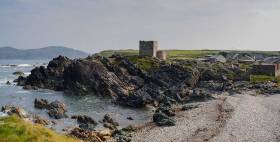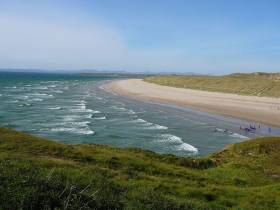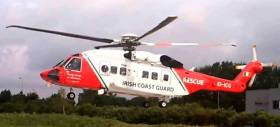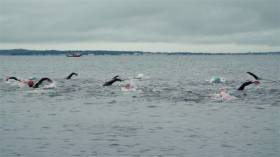Displaying items by tag: swimming
Search Resumes For Missing Holidaymaker Off North Donegal
#Missing - The search continues today (Wednesday 31 August) for a man missing after going swimming off the Inishowen Peninsula in Co Donegal this past Monday.
According to The Irish Times, the man in his 50s was reported missing at midnight on Monday by his family, with whom he was on a camping holiday on the Isle of Doagh just south of Malin Head.
The search comes just days since the body of soldier Gavin Carey was recovered off the south Donegal coast near Bundoran after he got into difficulty while swimming a week ago.
Body Of Missing Soldier Recovered Off Donegal Coast
#Donegal - A body recovered off the Donegal coast yesterday morning (Sunday 28 August) has been identified as missing soldier Gavin Carey, according to BreakingNews.ie.
Corporal Gavin Carey was reported missing after getting into difficulty while swimming with fellow soldiers at Tullan Strand last Tuesday 23 August, as previously reported on Afloat.ie.
Defence Forces chief of staff Vice Admiral Mark Mellett expressed his sorrow over the tragedy, with Taoiseach Enda Kenny also offering his condolences to Corporal Carey's family in Mullingar and colleagues at Custume Barracks in Athlone.
BreakingNews.ie has much more on the story HERE.
Search Resumes For Swimmer Missing Off Bundoran
#Missing - The search resumed at first light this morning (Wednesday 24 August) for a swimmer reported missing off Bundoran in Co Donegal yesterday evening.
BreakingNews.ie reports that the man got into difficulty while swimming at Tullan Strand.
The alarm was raised by a beachgoer in the adjacent car park after a group of swimmers called for help, according to RTÉ News.
Bundoran RNLI and the Irish Coast Guard's Sligo-based helicopter Rescue 118 are involved in the search that was suspended overnight.
Galway Bay Swim 2016 Captured On Video
#GalwayBaySwim - Hello Deer Media was on hand to capture on video the tremendous effort on display at last weekend's Frances Thornton Memorial Galway Bay Swim.
As previously reported on Afloat.ie, more than 100 swimmers crossed Galway Bay from Auginish to Salthill on Saturday 23 July for the 11th annual open sea swim in aid of Cancer Care West.
Big Turnout For 2016 Galway Bay Swim
#GalwayBaySwim - More than 100 swimmers crossed from Auginish to Salthill in the 11th annual Frances Thornton Memorial Galway Bay Swim at the weekend, as Galway Bay FM reports.
First across the bay on Saturday 23 July in his wetsuit was Stewart Moore with a time of 2h36m, followed by Dylan Barrett (1st male togs, 2h38m), John Burgess (2nd male wetsuit, 2h58m) and Aimee Walsh (1st female togs, 3h03m).
Full results can be found at the Galway Bay Swim website, while photos of the swimmers and winners are on Facebook.
The 13km open sea swim in aid of Cancer Care West saw tougher conditions than usual with a lot of jellyfish in the water.
"But there were no injuries and everyone thankfully finished and enjoyed the swim," said Fiona Thornton, daughter of Frances Thornton to whom the event is dedicated.
A documentary on the now annual fixture was screened in Galway earlier this year, as previously reported on Afloat.ie.
Skerries Lifeboat Launches To Swimmer In Difficulty
#RNLI - Skerries RNLI volunteers launched their Atlantic 85 inshore lifeboat on Saturday afternoon (23 July) after Dublin Coast Guard received a call from a concerned member of public about a swimmer in difficulty.
The lifeboat launched shortly after 12.30pm with Philip Ferguson at helm and crewed by Emma Wilson, Steven Johnson and AJ Hughes, after a swimmer was reported having difficulty returning to shore at the swimming area known locally as The Captains.
Within minutes the lifeboat was on scene, but there was no sign of any swimmers in the area. Before a search could be started Dublin Coast Guard received a second call to confirm that the swimmer had made it ashore and was safe and well. The lifeboat was stood down and returned to station.
Speaking after the callout, Skerries RNLI lifeboat press officer Gerry Canning said: :The member of the public who called Dublin Coast Guard was genuinely concerned for the swimmer and was right to make the call.
"Thankfully in this case our assistance wasn’t required, but our volunteer crew are always ready to respond to anyone in difficulty at sea."
The callout came two days after the Skerries lifeboat rescued four men from a speedboat grounded on rocks at Colt Island, as previously reported on Afloat.ie.
Ballycotton Lifeboat Rescues Swimmer In Difficulty
#RNLI - Ballycotton RNLI was launched around 2.30pm yesterday afternoon (Tuesday 12 July) to aid a man who had got into difficulty while swimming in East Cork's Ballyandreen Bay and called for help.
A member of the public heard the man's call and immediately alerted Valentia Coast Guard, who tasked Ballycotton's volunteer crew to launch both their all-weather and inshore lifeboats.
The inshore lifeboat was first to arrive on scene and the crew on board recovered the casualty from the water before transferring him to the all-weather lifeboat, where he was medically assessed, administered first aid and given oxygen.
The Irish Coast Guard's Waterford-based helicopter Rescue 117 was also tasked and arrived on scene around 3pm to airlift the casualty to Cork University Hospital, where he is said to be in a stable condition.
Speaking following the callout, Ballycotton RNLI coxswain Eolan Walsh said: "We would like to commend the member of the public who raised the alarm today as well as the immediate first aid action of the volunteer crew.
"Their quick-thinking and actions ensured that there was a positive outcome today for this casualty. We would also like to wish him a speedy recovery."
New Study Links Cold-Water Swimming With Increased Stroke Risk
#Swimming - You might think twice about that dip at the Forty Foot after new research identified a link between swimming in cold water and an increased risk of strokes.
Finnish news website YLE reports on the study by Chinese scientists who followed the habits of 900 members of a winter swimming club over a 30-year period.
And their results indicate a 10% higher risk of heart attacks ad strokes among the swimmers compared to the general population.
"This [study] emphasises the ill-effects of cold, which are well-known," said Prof Hannu Rintamäki of the Finnish Institute for Occupational Health. "Longer-term exposure to cold brings these kinds of results, ie that heart and circulation becomes heavier in cold water."
YLE has more on the story HERE.
Viral Video Shows Dangerous Salthill Storm Swimming 'Stunt'
#StormDesmond - It was a 'red' alert for western coastal counties this weekend as Storm Desmond blew in from the Atlantic with extreme gusts and downpours.
But amid the damage and disruption across the country, Galway-based photographer Cathal Devlin took to social media to share his dismay at the recklessness of two would-be divers who decided the stormy conditions presented the perfect time to take a dip.
Devlin's video of the "stunt" at Blackrock Diving Tower in Salthill – which clearly shows the young men ignoring basic water safety advice by diving into rough seas, with blasts of spray occasionally obscuring the pier – has gone viral in the 24 hours since he first uploaded it to Facebook. But he says he did not post it for entertainment purposes.
"I do not know if they are strong swimmers or not, that is not the case," Devlin writes. "If any one of them got into difficulties there was no one there to do anything for them.
"The voluntary and rescue services are kept busy enough without having to worry about this type of stupid behaviour."
Kinsale Lifeboat Called Out To Lone Swimmer
#RNLI - The volunteer crew of Kinsale RNLI launched at 1.20pm on Sunday last (4 October) to assist a swimmer who got into difficulties in the water around Sandycove Island.
Valentia Coast Guard requested the crew to launch their inshore lifeboat after walkers reported a person in difficulty in rough seas. He was quickly brought to safety, assisted by another swimmer and members of the public.
The swimmer said he had been alone but two pairs of shoes were found on the slipway, leading to fears that a second person may be in the water.
Gardaí, the Old Head Coast Guard shore unit and Irish Coast Guard helicopter Rescue 115 joined the search but no further casualties were found.
Speaking following the callout, Kinsale RNLI lifeboat operations manager John O'Gorman said: "Thankfully this swimmer was helped ashore and made a full recovery but we would urge everyone to pay particular attention to the RNLI's Respect the Water campaign.
"Irish waters are dangerously unpredictable, especially at this time of year. There are over 200 coastal drownings every year. The RNLI aims to halve that number by 2024 and the RNLI’s Respect the Water campaign will play a key role in achieving this.
"We still want you to enjoy the water, but we also want you to respect the water, acknowledge its dangers and never underestimate its power."
The RNLI urges anyone going on or in the water to let someone know where they are and when they will be back, and to carry a form of communication if at all possible.
If you do see someone in trouble, please do not enter the water to assist unless you are a trained lifesaver. Always dial 999 or 112 and ask for the coastguard.




































































